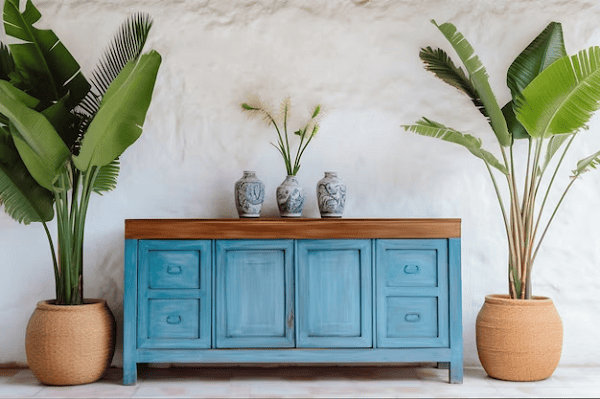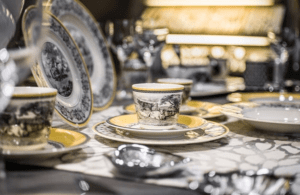Arrangements of sideboard- Arranging a sideboard involves both functional and aesthetic considerations. Here are some tips to help you arrange your sideboard in a visually pleasing and practical way:
- Balance and Symmetry:
- Place larger items in the center and smaller items on the sides to create a sense of balance.
- Symmetry can be visually appealing, so consider arranging items in pairs on either side of the sideboard.
- Functional Zones:
- Divide the sideboard into functional zones based on the items you plan to store or display.
- For example, designate a space for serving dishes, another for decorative items, and another for storage.
- Height Variation:
- Create visual interest by varying the height of items on the sideboard. Use taller items like vases or candle holders alongside shorter items like decorative bowls.
- Art and Mirrors:
- Hang a piece of art or a mirror above the sideboard to anchor the space and add visual interest.
- Make sure the size of the artwork or mirror is proportional to the sideboard.
- Decorative Items:
- Display decorative items such as sculptures, vases, or framed photos on the sideboard.
- Consider using items with colors that complement the overall color scheme of the room.
- Functionality:
- Keep in mind the practical use of the sideboard. If it’s in a dining room, you may want to store dinnerware, serving dishes, or table linens.
- In a living room, the sideboard could be used for media storage or as a display for books and decorative items.
- Lighting:
- Add table lamps or wall sconces on or above the sideboard to provide ambient lighting.
- Lighting can enhance the overall atmosphere and draw attention to key items on the sideboard.
- Plants and Greenery:
- Incorporate plants or floral arrangements to bring a touch of nature into the space.
- Plants add freshness and can soften the lines of the sideboard.
- Personal Touch:
- Include personal items that reflect your style and personality. This could be family photos, travel souvenirs, or meaningful objects.
- Seasonal Changes:
- Consider updating the arrangement with the seasons. For example, during holidays, you might incorporate seasonal decor.
Remember, these are just guidelines, and personal preferences play a significant role in arranging furniture and decor. Experiment with different arrangements until you find a setup that suits your taste and complements the overall design of your space.
What is Arrangements of sideboard
The term “arrangements of sideboard” generally refers to how items are organized or positioned on a sideboard. A sideboard is a piece of furniture that typically has a flat top and cabinets or drawers for storage. It’s often used in dining rooms, living rooms, or hallways for both functional and decorative purposes.
Arranging a sideboard involves placing items on and around it in a way that is visually appealing and serves a practical purpose. Here are some common elements that people may arrange on a sideboard:
- Functional Items: Depending on the room, a sideboard might hold functional items such as dishes, glassware, or serving platters in a dining room, or electronics and media in a living room.
- Decorative Items: These can include vases, candles, sculptures, or artwork that add a decorative touch to the space.
- Storage: Sideboards often have cabinets or drawers for storage. The arrangement of items inside these storage spaces is also part of the overall arrangement.
- Symmetry and Balance: Achieving a sense of balance and symmetry can be visually pleasing. Placing items in pairs or balancing the arrangement on either side of the sideboard can contribute to this.
- Personal Touch: Adding personal items such as family photos, travel souvenirs, or items with sentimental value can make the arrangement more personalized.
- Seasonal Decor: Some people like to change the arrangement of their sideboard based on the seasons or holidays, incorporating seasonal decor and colors.
The arrangement of a sideboard is often influenced by the overall design and style of the room, as well as the individual preferences and tastes of the person arranging it. It’s a creative process that allows for a mix of functionality and aesthetics to enhance the overall look and feel of the space.
Who is Required Arrangements of sideboard
If you’re asking about who requires or is involved in arranging a sideboard, it typically falls under the responsibility of the homeowner or the person responsible for the interior design of a space. Here are a few scenarios where arrangements of a sideboard might be considered:
- Homeowner or Resident: In a residential setting, the homeowner or resident is usually the one who decides how to arrange furniture and decor, including the sideboard.
- Interior Designer: If a professional interior designer is hired, they may provide guidance on how to arrange furniture and decor, taking into consideration the overall design scheme, color palette, and the client’s preferences.
- Event Planner: In some cases, for events or special occasions, an event planner might be involved in arranging sideboards for functions like weddings, parties, or corporate events.
- Furniture Store or Showroom: If you’re purchasing a sideboard from a furniture store, their staff might assist you with suggestions on how to arrange it effectively.
- Staging Professional: When preparing a home for sale, a staging professional may arrange furniture and decor, including the sideboard, to make the space more appealing to potential buyers.
Ultimately, the arrangements of a sideboard depend on the individual’s taste, the function of the room, and any specific design considerations. It’s a creative process that aims to achieve both functionality and aesthetic appeal within a given space.
When is Required Arrangements of sideboard

The arrangement of a sideboard can be required or considered in various situations and contexts. Here are some scenarios when arranging a sideboard might be necessary or beneficial:
- Home Decorating:
- When moving into a new home or redecorating, arranging a sideboard is part of the overall interior design process. It helps create a cohesive and visually pleasing look in a room.
- Special Occasions and Events:
- For special occasions such as holidays, parties, or gatherings, you might want to arrange the sideboard to showcase seasonal decor, serve as a display for appetizers, or contribute to the overall ambiance.
- Home Staging:
- If you are preparing your home for sale, staging professionals may arrange furniture, including the sideboard, to make the space more appealing to potential buyers.
- Seasonal Changes:
- Some people rearrange their sideboards seasonally, incorporating different decor or adjusting the arrangement based on the time of year.
- Functional Needs:
- When there’s a change in the function of a room or the items stored in the sideboard (e.g., switching from everyday dishes to formal dinnerware), you might need to rearrange the sideboard to accommodate these changes.
- Interior Redesign:
- During a larger interior redesign or renovation project, the arrangement of furniture, including the sideboard, is often reconsidered to optimize the use of space and reflect the updated design.
- Personal Preference Changes:
- If your personal taste or preferences change, you may choose to rearrange the sideboard to better align with your current style.
- Entertaining Guests:
- When hosting guests, arranging the sideboard with serving dishes, drinks, or decorative elements can enhance the hospitality and presentation of the space.
In essence, the arrangement of a sideboard can be a dynamic process influenced by various factors, including aesthetics, functionality, personal preferences, and the specific needs of the occasion or environment. It’s a creative aspect of home decor that allows for flexibility and adaptation over time.
Where is Required Arrangements of sideboard
The arrangements of a sideboard are typically required or considered in various locations within a home or other relevant settings. Here are common places where you might arrange a sideboard:
- Dining Room:
- A sideboard is a common and functional addition to a dining room. It’s often used for storing table linens, dishes, and serving pieces. The arrangement in this space is influenced by both practical considerations and aesthetic preferences.
- Living Room:
- In a living room, a sideboard might serve as a decorative and functional piece of furniture. It can be arranged to hold items like books, photo frames, or electronic equipment. The arrangement in the living room is often more focused on aesthetics and complementing the overall decor.
- Hallway or Entryway:
- Some people place sideboards in hallways or entryways to create a welcoming atmosphere. Arranging items like keys, decorative bowls, or artwork on the sideboard can enhance the entrance of a home.
- Bedroom:
- In a bedroom, a sideboard can function as a dresser or provide additional storage. The arrangement may include items like clothing, accessories, or personal items.
- Home Office:
- In a home office, a sideboard can be used for storage of office supplies, files, or equipment. The arrangement is often focused on maximizing organization and efficiency.
- Entertainment Room:
- If you have a dedicated entertainment or media room, a sideboard may be used to store DVDs, gaming consoles, or other entertainment-related items. The arrangement can be tailored to suit the needs of the space.
- Special Events Venue:
- For events such as weddings, parties, or corporate functions held in venues with sideboards, arranging the sideboard might be necessary to display decor, serve food and drinks, or enhance the overall ambiance.
- Hotel Lobbies or Restaurants:
- Commercial spaces like hotel lobbies or upscale restaurants often use sideboards for both functional storage and decorative purposes. The arrangement in such settings is typically designed to create a sophisticated and welcoming atmosphere.
The specific location and arrangement of a sideboard depend on the intended function of the space and the individual preferences and needs of the user. Whether in residential or commercial settings, the sideboard’s arrangement contributes to the overall design and functionality of the environment.
How is Required Arrangements of sideboard
The arrangements of a sideboard involve thoughtful consideration of both aesthetic and functional aspects. Here’s a step-by-step guide on how to approach the arrangement of a sideboard:
- Define Purpose:
- Determine the primary purpose of the sideboard. Is it mainly for storage, display, or a combination of both? Understanding its function will guide your arrangement decisions.
- Clear the Surface:
- Start with a clean slate by clearing the top surface of the sideboard. Remove any items that are not intended to be part of the new arrangement.
- Group Items:
- Group items based on their function or theme. For example, group together decorative items, serving ware, or storage baskets.
- Consider Symmetry:
- If symmetry appeals to you, consider arranging items symmetrically on either side of the sideboard. This can create a balanced and visually pleasing look.
- Vary Heights and Sizes:
- Create visual interest by varying the height and size of items. Place taller items like vases or candle holders alongside shorter items like decorative bowls.
- Use Trays and Containers:
- Consider using trays or containers to corral smaller items. This can help create a more organized and cohesive look.
- Create Zones:
- Divide the sideboard into functional zones. For example, designate one area for decorative items, another for serving dishes, and another for storage.
- Add Lighting:
- If the sideboard is in a dimly lit area, consider adding lighting. Table lamps or wall sconces can provide both functional and ambient lighting.
- Incorporate Artwork or Mirrors:
- Hang artwork or a mirror above the sideboard to anchor the arrangement. The size of the artwork or mirror should be proportional to the sideboard.
- Personalize with Meaningful Items:
- Incorporate personal items that hold sentimental value, such as family photos or heirlooms. This adds a personal touch to the arrangement.
- Consider Seasonal Changes:
- If you enjoy changing decor with the seasons, consider incorporating seasonal items. This could include holiday decorations, seasonal flowers, or themed decor.
- Step Back and Assess:
- Once you’ve arranged the sideboard, step back and assess the overall look. Make adjustments as needed, ensuring that the arrangement aligns with your vision for the space.
Remember that arranging a sideboard is a creative process, and there are no strict rules. It’s an opportunity to showcase your style and preferences while maintaining a balance between functionality and aesthetics. Feel free to experiment and make changes until you achieve an arrangement that feels right for the space.
Case Study on Arrangements of sideboard
Client Background:
Mr. and Mrs. Johnson, a couple in their early 40s, recently moved into a newly built modern home with an open-concept living and dining area. They are keen on creating a stylish and functional space that reflects their contemporary taste. The dining area features a sleek, wooden sideboard with ample storage space.
Objectives:
- Functionality: The sideboard should provide practical storage for dining essentials such as tableware, linens, and serving dishes.
- Aesthetics: The arrangement should complement the modern design of the home, incorporating a color scheme that harmonizes with the surrounding decor.
- Personal Touch: The arrangement should incorporate personal items and elements that reflect the couple’s interests and experiences.
Arrangement Process:
- Functional Organization:
- The couple begins by emptying the sideboard and categorizing items based on functionality. They allocate specific sections for everyday tableware, formal dinnerware, table linens, and serving platters.
- Color Coordination:
- Given the modern design of their home, the couple opts for a color scheme of neutral tones with pops of bold colors. They select decorative items and accessories in shades that complement the overall design.
- Symmetry and Balance:
- Wanting a clean and balanced look, the couple decides on a symmetrical arrangement. They place matching sets of vases on either side of the sideboard and balance the display with a centered piece of artwork above.
- Personalization:
- To add a personal touch, the couple includes framed photos of their travels on one side of the sideboard. This not only brings sentimental value but also contributes to the overall aesthetics.
- Incorporating Greenery:
- To introduce a natural element, the couple places a low-maintenance succulent arrangement in the center of the sideboard. This adds a touch of greenery without overwhelming the space.
- Practical Lighting:
- Recognizing the importance of lighting, they install sleek, modern wall sconces on either side of the artwork above the sideboard. This provides both ambient lighting and highlights the arrangement.
- Adjustments for Seasons:
- Considering the changing seasons, the couple decides to update the sideboard arrangement with seasonal decor. In the fall, they incorporate warm-toned candles and decorative pumpkins, while in the spring, they introduce fresh flowers and lighter colors.
- Final Touches:
- The couple steps back to assess the arrangement, making minor adjustments to ensure a cohesive and visually appealing display. They appreciate the balance achieved between functionality and aesthetics.
Outcome:
The arranged sideboard becomes a focal point in the dining area, seamlessly blending practicality with the couple’s modern and personal style. The thoughtful arrangement contributes to a welcoming atmosphere in their home, making the dining area a space they enjoy and are proud to share with friends and family.
White paper on Arrangements of sideboard
Title: Enhancing Home Aesthetics and Functionality Through Thoughtful Arrangements of Sideboards
Abstract:
This white paper explores the art and science of arranging sideboards within residential spaces, with a focus on optimizing both aesthetics and functionality. From defining the purpose of sideboards to the principles of arrangement, this document serves as a comprehensive guide for homeowners, interior designers, and enthusiasts seeking to create visually appealing and practical interior spaces.
1. Introduction:
Sideboards, often considered versatile pieces of furniture, play a crucial role in enhancing the overall ambiance of a room. This section introduces the significance of sideboards in home decor and outlines the key objectives of effective arrangements.
2. Defining Purpose:
Understanding the intended function of a sideboard is paramount. Whether utilized for storage, display, or a combination of both, the arrangement should align with the practical needs of the space. Case studies and examples illustrate how purpose-driven arrangements can elevate the functionality of sideboards.
3. Aesthetic Considerations:
This section delves into the aesthetic principles governing sideboard arrangements. Topics include color coordination, symmetry, balance, and the incorporation of personal elements. Real-life examples demonstrate how these principles can be applied to achieve visually appealing setups.
4. Practical Tips for Arrangement:
Practicality is key when arranging sideboards. This section provides actionable tips for organizing items, varying heights, using trays and containers, and creating functional zones. It also addresses the role of lighting, artwork, and mirrors in enhancing the overall arrangement.
5. Seasonal Adaptations:
Recognizing the dynamic nature of home decor, this section discusses how sideboard arrangements can be adapted to suit different seasons or special occasions. Examples showcase creative ways to incorporate seasonal elements without compromising the functionality of the sideboard.
6. Case Studies:
Several detailed case studies highlight the diverse applications of sideboards in various home settings. Each case study explores the unique objectives, challenges, and solutions in arranging sideboards, providing practical insights for readers.
7. Future Trends:
Anticipating evolving trends in interior design, this section speculates on the future of sideboard arrangements. It explores emerging styles, materials, and technologies that may influence how sideboards are arranged in the years to come.
8. Conclusion:
Summarizing key takeaways, this section emphasizes the symbiotic relationship between functionality and aesthetics in sideboard arrangements. It encourages readers to experiment, personalize, and adapt arrangements to suit their individual preferences and the evolving dynamics of their living spaces.
9. References:
Citing relevant studies, design principles, and real-world examples, this section provides a comprehensive list of references for readers interested in further exploration of sideboard arrangements.
10. Acknowledgments:
Acknowledging the contributions of experts, designers, and homeowners who have shared their insights, this section expresses gratitude for the collaborative effort in creating this white paper.
This white paper aims to serve as a valuable resource for anyone seeking to enhance their home environment through thoughtful and purposeful arrangements of sideboards.
Industrial Application of Arrangements of sideboard
While sideboards are traditionally associated with residential settings, they can find practical applications in industrial environments as well. Here is an exploration of how the arrangements of sideboards can be applied in an industrial context:
1. Warehouse Storage and Organization:
- In industrial warehouses or storage facilities, sideboards can be adapted as storage units for tools, equipment, or small parts. Proper arrangement within these sideboards facilitates easy access and efficient organization of items.
2. Workshop Tool Organization:
- Workshops and manufacturing plants often have various tools and equipment. Sideboards can be used to organize and store these tools systematically, ensuring that they are readily available for use. Arranging tools based on size, type, or frequency of use improves workflow efficiency.
3. Office and Administrative Spaces:
- In industrial office spaces, sideboards can serve as multifunctional storage units. Arranging office supplies, documents, and other essential items in an organized manner contributes to a tidy and efficient work environment.
4. Employee Break Areas:
- Sideboards can be utilized in break areas or cafeterias within industrial facilities. Arranging these spaces with sideboards for storing utensils, napkins, or employee personal items can contribute to a more organized and inviting break area.
5. Display and Showcase in Industrial Showrooms:
- Industrial showrooms or exhibition spaces can use sideboards for displaying products, samples, or informational materials. Proper arrangement of these items can create an engaging and informative showcase for clients and visitors.
6. Reception and Waiting Areas:
- In reception or waiting areas of industrial facilities, sideboards can be arranged to hold brochures, magazines, or promotional materials. This not only contributes to a welcoming atmosphere but also ensures that information is easily accessible to visitors.
7. Laboratory Equipment Storage:
- Laboratories in industrial settings often have a variety of instruments and equipment. Sideboards can be used to store and arrange these items, providing a designated space for lab tools and ensuring a clean and organized workspace.
8. Control Room Organization:
- In control rooms where operators manage and monitor industrial processes, sideboards can be arranged to store manuals, documents, or control devices. This contributes to an organized and efficient control center.
9. Event Spaces and Conferences:
- For industrial events, conferences, or training sessions held within a facility, sideboards can be arranged to hold informational materials, refreshments, or promotional items. This enhances the overall experience for attendees.
10. Employee Locker Rooms:
- In industrial settings with locker rooms, sideboards can be used for storing personal items, uniforms, or safety gear. Proper arrangements help streamline the process of accessing and storing these items.
In industrial applications, the key is to adapt the concept of sideboards to meet specific organizational and storage needs. Proper arrangements contribute to increased efficiency, improved aesthetics, and a more organized industrial workspace.








